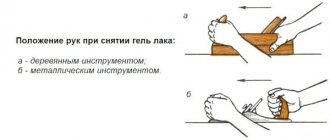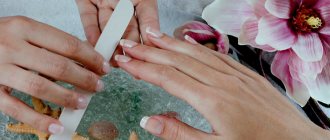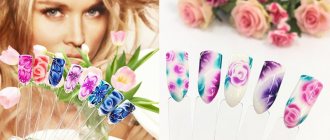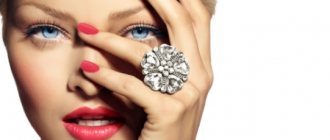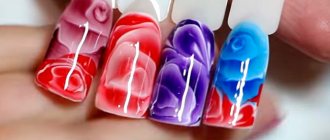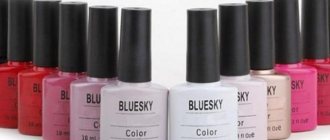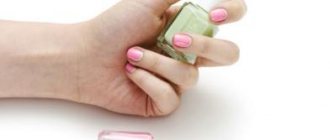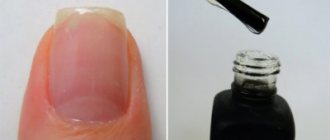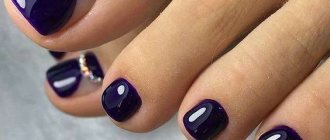Since ancient times, people have tried to decorate the world around them and themselves. Today everyone knows such concepts as “nail polish” and “extensions”, but despite the prosperity of the nail industry, not everyone knows what shellac is. Many years before our era, people began to monitor the condition of their nails.
Thus, during archaeological excavations, a tomb was discovered with the retinue of the ancient pharaoh Nuser, who was responsible for his nails, that is, the first manicurists in history. The famous Cleopatra carefully looked after her appearance and used henna to give her nails color. Depending on the shade, it was possible to determine which class the Egyptian belonged to; noble people painted their nails with red flowers, simple ones with green, and the lower ones were allowed to use pale tones.
The ancient Chinese believed that long nails promoted a connection with the gods and signified the wisdom of the person wearing them. The emperor's nails were painted with a special composition consisting of wax and fruit tree sap. Later, metal tips appeared that served as protection for nails. It was considered a shame if such an attribute was lost, since the older the tip, the more decent the person. The first moisture-resistant varnish coating was invented by Charles Revson.
In 1933, he presented his first collection of varnishes for sale. It was he who suggested using nail polish and lipstick of the same color, and introduced the fashion for red lips and nails.
Later, one dentist accidentally came up with nail extensions. Fred Slack damaged his nail, which greatly interfered with the dentist's work, then he repaired the nail with the help of foil and filling compound. Realizing the significance of the discovery, he began to move towards the nail industry, promoting and improving the composition. At the same time, several more dentists came to this discovery and began selling their innovations to nail shops.
Regular polish and extensions have become the main materials for decorating nails, but each has its own drawback:
- The varnish coating is not durable, which leads to chips, scratches and loss of the original glossy shine after a day or two
- Extensions are harmful to natural nail plates, especially when removed. In addition, the process itself takes a lot of time; not everyone dares to spend half a day in the salon
Understanding the imperfections of these coatings, in 2010 the CND company released an innovative shellac coating, which instantly made a splash in the nail industry. Other companies did not stand aside and also began to produce similar products.

Gel polish is a special polymer that hardens under the influence of UV or LED rays, creating a durable glossy coating.
Benefits of shellac:
- Lasts 10-15 days
- Glossy shine does not fade
- Easy to apply and go on
- Does not chip or scratch
- Removal does not damage the nail plate
- The surface of the nail is absolutely smooth
- Helps grow strong natural nails
What is gel nail polish
This term refers to a material that is in great demand today. It is used in many beauty salons to obtain a beautiful and durable manicure that does not require correction for 2-3 weeks.
This product is a hybrid of an ordinary varnish with a modeling gel. It is easily applied to nails and hardens under the influence of ultraviolet radiation. The composition is completely safe for people. It does not have a strong odor, is resistant to mechanical factors, and retains its color and glossy structure for a long time.
Important
One of the key things that concerns women who want to get a shellac manicure is whether CND shellac will damage their nails.
No, it doesn't hurt if you remove it correctly. It is also important to keep your nails and hands moisturized, as shellac can cause the skin around your nails and cuticles to become very dry. We recommend using hand cream morning and evening.
There is some concern about exposure to UV radiation from the drying lamp when drying shellac. You may want to bring your own hand lotion with SPF if you have delicate hands or if you get shellac manicures regularly.
Who invented it and when
Gel polish first appeared not so long ago. This is thanks to Creative Nail Design, or CND for short. It was led by Stuart Nordstrom. Initially, this person was in no way connected with the fashion world. He worked as a dentist. One day, a manicurist came to see the doctor and noticed that the composition for a temporary filling smelled the same as the mixture for making porcelain nails. This happened in 1978.

It took Stuart Nordstrom approximately six months and hundreds of experiments to create a monomer with the ideal formula. It froze under the influence of ultraviolet light. Thus, gel polish was invented, which is often called “shellac”.
How long does gel polish last?
According to generally accepted standards, manufacturers promise that after applying gel polish, nails will remain flawless for 2 weeks. At the same time, chips or cracks will not appear on them.
Some brands even promise 3 weeks of perfect operation. Today this is considered quite real, because modern brands compete fiercely with each other and are constantly looking for ways to increase the attractiveness of their products.

How the nail industry has changed
Nowadays there are many cosmetic products on the market. Although gel polishes were initially presented as professional products, their analogues are now widely represented in the mass market.
They are single-phase products that you simply need to cover the nails with and dry this layer. At the same time, manufacturers promise durability comparable to professional analogues. However, experts say that these are all just advertising promises.

So, today the following types of gel polishes are on sale:
- Three-phase - are classic compositions. Their application involves applying 3 consecutive layers - base, gel polish itself and top coat. Each layer must be polymerized in an ultraviolet or LED lamp. This technology ensures the creation of a durable manicure that retains its attractive appearance for at least 2 weeks. However, the process of performing a manicure takes a lot of time. Three-phase formulations are offered by almost all well-known brands - in particular, FOX, Beautix, Tertio, UNO.
- Biphasic - less common than other varieties. The composition includes color coating and top. In rare cases, the product combines a base and a color coating. Applying two coats instead of three helps reduce the duration of the procedure and reduce its cost. Moreover, the durability of such a manicure does not exceed 10 days. An example of such a gel polish is the product of the Patrisa Nail brand, which is presented in the Dream Pink collection.
- Single-phase - involves only one coating. Therefore, it is applied in one stage. This composition combines all the products - base, color coating and top. This option is considered the most time-efficient. The procedure is carried out quite quickly. However, in terms of durability, such products are certainly inferior to three-phase ones. These products are offered by many cosmetic companies - in particular, Masura, Irisk Professional, Patrisa Nail, TNL.

Uses
Historical
In the early and mid-twentieth century, orange shellac was used as a one-part finish (a combination of stain and varnish-like topcoat) on decorative wood paneling used on walls and ceilings in homes, especially in the United States. In the American South, the use of knotty pine plank sheathing coated with orange shellac was once as common in new construction as drywall is today. It was also often used on kitchen cabinets and wood floors before the advent of polyurethane.
Before the advent of vinyl, most phonograph records were pressed from shellac compounds.[17][18] From 1921 to 1928, 18,000 tons of shellac were used to create 260 million records for Europe.[7] In the 1930s, it was estimated that half of all shellac was used for gramophone records.[19] The use of shellac for records was common until the 1950s and continued into the 1970s in some non-Western countries.
Until recent technological advances, shellac (French lacquer) was the only adhesive used in the manufacture of ballet dancers. pointe shoes to strengthen the box (toe area) to support the dancer on pointe. Many pointe shoe makers still use traditional techniques, and many dancers use shellac to bring life to a softening pair of shoes.[20]
Shellac has historically been used as a protective coating on paintings.
Braille sheets were coated with shellac to protect them from wear due to being read by hand.
Shellac has been used since the mid-nineteenth century to produce small molded items such as picture frames, boxes, toiletries, jewelry, inkwells, and even dentures. Advances in plastics have made shellac obsolete as a molding compound.
Shellac (orange and white) was used both in the field and in the laboratory to bond and stabilize dinosaur bones until about the mid-1960s. Although it was effective at the time, the long-term negative effects of shellac (which is organic in nature) on dinosaur bones and other fossils are debated, and today shellac is very rarely used by professional fossil conservators and preparations.
Shellac was used to fix the inductor, motor, generator and transformer windings. It was applied directly to single-layer windings in an alcohol solution. For multilayer windings, the entire coil was immersed in a shellac solution, then drained and placed in a warm place to allow the alcohol to evaporate. The shellac locked the coils of wire in place, provided additional insulation, prevented movement and vibration, and reduced buzzing and humming. In motors and generators, it also helps transmit the force created by magnetic attraction and repulsion from the windings to the rotor or armature. Recently shellac has been replaced in these applications by synthetic resins such as polyester resin. Some applications use shellac mixed with other natural or synthetic resins such as pine tar or phenol-formaldehyde resin, of which Bakelite is best known for electrical use. Mixed with other resins, barium sulfate, calcium carbonate, zinc sulfide, aluminum oxide and/or copper carbonate (malachite), shellac is a component of a thermosetting cementitious coating used to attach bases or sockets to light bulbs of electric lamps.
Current
It is the centerpiece of the traditional "French Polish" method of finishing furniture, fine stringed instruments, and pianos.
Shellac is edible, used as a glazing agent on tablets (see filler) and sweets, in the form of a pharmaceutical glaze
(or,
confectionery glaze
). Because of their acidic properties (resistance to stomach acids), shellac-coated tablets can be used for sustained release in the intestines or colon.[21] Shellac is used as a "waxy" coating on citrus fruits to extend their shelf life. It is also used to replace natural apple wax, which is removed during the peeling process.[22] When used for this purpose it has Food Additive Number E E904.
Shellac is applied with a standard or modified Huon-Stuehrer nozzle, can be economically sprayed onto a variety of smooth candies such as chocolate covered peanuts. Irregularities in the surface of the sprayed product usually result in the formation of unsightly aggregates ("lac-agg"), making this method unsuitable for processing foods such as walnuts or raisins (however, chocolate-coated raisins have a smooth surface that allows for successful spraying using a modified Huon-Stuehrer attachment).
Shellac is an odor and stain blocker, so it is often used as a base for “problem-solving” primers. Although its resistance to abrasives and many common solvents is not very good, shellac provides an excellent barrier against the penetration of water vapor. Shellac-based primers are an effective sealant for controlling odors associated with fire damage.
Shellac was traditionally used as a dye for cotton and especially silk fabric in Thailand, especially in the northeastern region.[23] It produces a range of warm colors from pale yellow to deep orange-red and dark ocher.[24] Naturally dyed silk fabric, including those using shellac, is widely available in rural areas of the northeast, especially in Ban Hwao District, Chaiyaphum Province. The Thai name for the insect and substance is "khrang" (Thai: ครั่ง).
Wood finishing
Wood finishing is one of the most traditional and popular uses of shellac mixed with solvents or alcohol. This dissolved shellac liquid applied to a piece of wood is an evaporation finish: the alcohol of the shellac mixture evaporates, leaving a protective film.[25]
Shellac as a wood finish is natural and non-toxic in its pure form. The shellac finish is UV resistant. In terms of water resistance and durability, it is not inferior to synthetic finishing products.[26]
Because shellac is compatible with most other finishes, it is also used as a barrier or primer coat. wood to prevent resin or pigments from bleeding into the final finish or to prevent stain from staining.[27]
Another
Shellac is used:
- when tying artificial flies for trout and salmon, where shellac was used to seal all the scraps on the head of the fly.
- combined with wax to preserve and add shine to citrus fruits such as lemons.
- in dental technology, where it is sometimes used in the production of individual impression trays and (partial) dentures.
- as a binder in Mascara.
- for cycling, as a protective and decorative coating for bicycle handlebar tape,[28] and as a hard-to-dry adhesive for tubular bicycle tires, especially for track racing.[29]
- for reattaching ink sacs when restoring a fountain pen harvest, preferably the orange variety.
- for attaching pads to the keyboard cups of woodwind instruments.
- behind Luthier appliqué to bind the wood fibers and prevent tearing of the soft spruce deck.
- for stiffening and waterproofing felt hats, for finishing wood[30] and as an integral part of gossamer
(or
gossamer
for short), gauze coated with shellac and an ammonia solution used in the shell of traditional silk tops and riding caps. - for attaching insects, in the form of a gel adhesive mixture with 75% ethyl alcohol.[31]
- as a binder in the manufacture of abrasive wheels, [32] imparting flexibility and smoothness, which is not found in ceramic-bonded wheels. "Elastic" adhesive-coated discs usually contain gypsum, giving a stronger bond when mixed with shellac; a mixture of dry gypsum powder, abrasive (for example, corundum/aluminum oxide Al2O3), shellac is heated and the mixture is pressed into a mold.
- In fireworks, pyrotechnic compositions are used as low-temperature fuels, where they allow the creation of pure "green" and "blue" colors that are difficult to achieve with other fuel mixtures.
- In watchmaking, due to its low melting point (about 80–100 °C (176–212 °F)), shellac is used in most mechanical movements to adjust and attach the bezel stones to the surface. pallet fork and fix the roller on the roller table balancer. Also for attaching small parts to the “wax chuck” (faceplate) on a watchmaker’s lathe.
- in the early twentieth century it was used to protect some military rifle stocks.[33]
- in Jelly belly jelly beans are combined with beeswax to give them a final shine and polish.[34]
- In modern traditional archery, shellac is one of the hot-melt adhesives/resins used to attach arrowheads to wooden or bamboo arrow shafts.
- Sanding sealant, a solution of shellac dissolved in alcohol, is widely sold for sealing sanded surfaces, usually wood surfaces, before a final coat of a more durable finish. Similar to French Polish, but more diluted.
- as a top coat in nail varnish (although not all nail varnish marketed as "shellac" contains shellac, and some nail varnishes not so labeled do)
The CND brand and the creation of shellac
In 2010, CND introduced a new product to the market - shellac. It was invented by former dentist Stuart Nordstrom. The name of the substance comes from the resin that is formed as a result of the vital activity of certain types of insects. However, the resin itself is not included in the product. Its polymer composition is a combination of gel and varnish.
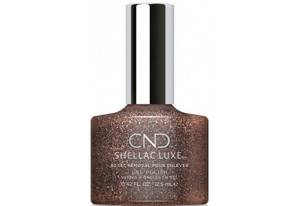
The advantages of using such a tool include the following:
- high degree of durability - the coating lasts on the nails for up to 2 weeks;
- glossy shine - but it does not disappear over time;
- resistance to chips and scratches;
- ease of application;
- no risks for nail plates;
- possibility of obtaining a flat surface.

Such characteristics ensure the rapid growth in popularity of this type of coating. After some time, many brands began to produce similar formulations. However, the name “shellac” of the CND brand began to be used for products of other brands.
Gallery
- Light shellac flakes
- Dewaxed Bona (L) and Waxy #1 Orange (R) shellac flakes. The last one is orange shellac, a traditional shellac that has been used for decades on wood wall panels, kitchen cabinets and tool handles.
- Close-up of #1 Orange Wax Flakes (L) and Bona Dewaxed Shellac (R). The first, orange shellac, is a traditional shellac that has been used for decades on wood wall panels and kitchen cabinets.
- A "quick and dirty" example of a pine board coated with 1-5 coats of Dewaxed Dark Shellac (a darker version of traditional orange shellac)
Contraindications
Gel polish is considered a relatively safe product. However, it is characterized by many contraindications. These include the following:

- Pregnancy - in general, this period is not considered a contraindication to the use of gel polish. However, doctors do not recommend performing the procedure during the first 3-4 months, when the child’s internal organs are forming.
- Poor condition of the nail plates - applying gel polish will aggravate the problems of damaged nails. Therefore, before performing the procedure, a rehabilitation course is required.
- Allergic reactions - people who have such problems are recommended to give preference to special hypoallergenic substances. It is important to remember safety precautions. These include good ventilation of the room and protection of the skin from the product. Sometimes there is an allergy to the sticky layer. In such a situation, it is necessary to give preference to coatings without dispersion.
Recommendations
- "Shellac". Cambridge Dictionary
. Retrieved October 19, 2022. - "shellac". Online Dictionary of Etymology
. Retrieved March 17, 2015. - Bangali Babu; D. N. Goswami (2010). Processing, chemistry and application of Lac
. New Delhi, India: Chandu Press. clause 4. - ^ a b c d
Naturalhandyman.com: PROTECTION, PRESERVATION AND PROTECTION WITH SHELLAC: The History of Shellac - Yakubu, Jeanne (November 30, 2010). "Questions and answers about shellac." Vegetarian Resource Group
. Retrieved July 3, 2014. - Velji, Vijay (2010). "Origin and production of shellac". shellacfinishes.com. Retrieved July 3, 2014.
- ^ a b
Berenbaum, May (1993).
Ninety-nine Larvae, Mites and Eaters
. University of Illinois Press. n.. ISBN 978-0-252-02016-2. - "Dissolving and Mixing Shellac Flakes: "Pound Cut" Chart for Shellac." shellac.net
. Retrieved October 19, 2022. - American Woodworker: Tips for Using Shellac
- Tutorial on French polishing guitars
- https://pubchem.ncbi.nlm.nih.gov/compound/shellac gives the main component as 9,10,15-trihydroxypentadecanoic acid, as well as (2R, 6S, 7R, 10S)-10-hydroxy-6- (hydroxymethyl )-6-methyltricyclound-8-ene-2,8-dicarboxylic acid, molecular formula C30HAC50O11 with a molecular weight of 586.7 g/mol
- "Properties of Shellac CAS No. 9000-59-3."
- Merck Index, 9th ed. page 8224.
- Merrifield, Mary (1849). Original Treatises on the Art of Painting
. Mineola, New York: Dover Publ. ISBN 978-0-486-40440-0. - Derrick, Michelle R.; Stulik, Dusan C.; Landry, James M.; Bouffard, Stephen P. (1992). "Identification of furniture finish using infrared microscopy with line mapping." JAIC (Journal of the American Institute of Conservation)
.
31
(2, article 6): 225 to 236. doi:10.2307/3179494. JSTOR 3179494. - Woods, K. (1994). "The Nature and Treatment of Wax and Shellac Seals". Journal of the Society of Archivists
.
15
(2): 203–214. Doi:10.1080/00379819409511747. - Reading, Alexander (2006). "On the record." Cambridge Opera Magazine
.
18
(1):59–82. Doi:10.1017/S0954586706002102. - Melillo, Edward (2014). "Global Entomologies: Insects, Empires, and the 'Synthetic Age' in World History." Past present
.
223
: 233–270. Doi:10.1093/pastj/gtt026. - "How shellac is made." Post Office (Adelaide, SA: 1912–1954). December 18, 1937. Retrieved July 3, 2014.
- "Pointe Shoe Care - Bloch Australia." Bloch Australia
. Retrieved March 17, 2016. - Shellac film coatings that provide release at a selected pH and method - US Patent 6620431 Archived September 29, 2007 Wayback Machine
- "Apple Apple: Consumers - Frequently Asked Questions: Apples and Wax." Archived December 3, 2010. Retrieved February 3, 2012.CS1 maint: BOT: Source URL status unknown (link)
- Suanmuang Thulafan, Phunsap, Silk Dyeing with Natural Dyes in Northeast Thailand
, 1999, pp. 26-30 (in Thai) - Punyaprasop, Darani (ed.) Color And Pattern in Native Fabric
, 2001, p. 253, 256 (in Thai) - Marshall, Chris (2004). Woodworking Tools and Techniques: An Introduction to Woodworking Basics
. Creative Publishing International, USA. paragraph 137. - "Wood Finishing FAQs: Shellac vs Polyurethane vs Lacquer." Hammer
. Retrieved August 4, 2022. - Shellac, WoodworkDetails.com: Shellac as a woodworking finish[ circular link
] - “Shellac and twine make the steering wheel beautiful.” Get out of your backdoor
. August 21, 2005. Retrieved March 17, 2015. - Installation of tubular tires for Jobst Brandt
- Jewitt, Jeff. "Shellac: Traditional Finishes Still Give Excellent Results." Antique restorers
. Retrieved March 16, 2015. - Fly Times: insect repellent shellac gel
- Stephen Malkin; Changsheng Guo (2008). Grinding Technology: Theory and Application of Abrasive Machining
. Industrial press. paragraph 5. ISBN 9780831132477. - “What finishes do I have in stock?” Russian Mosin-Nagant Forum
. Retrieved March 21, 2015. - Questions and Answers - Jelly Belly Marmalade Archived January 5, 2014 Wayback Machine
